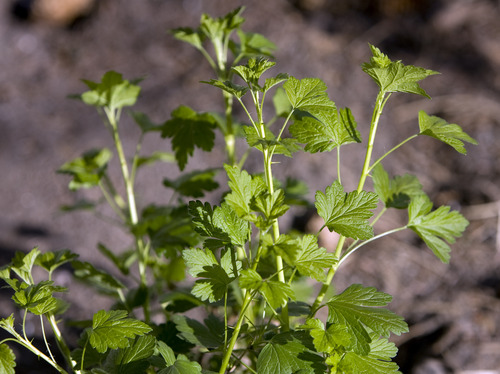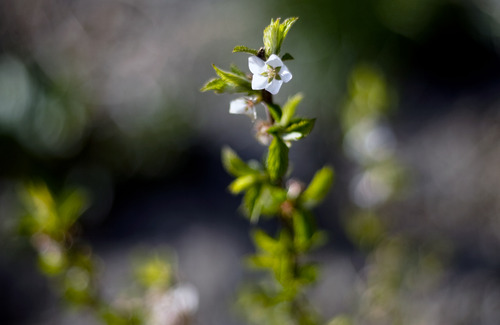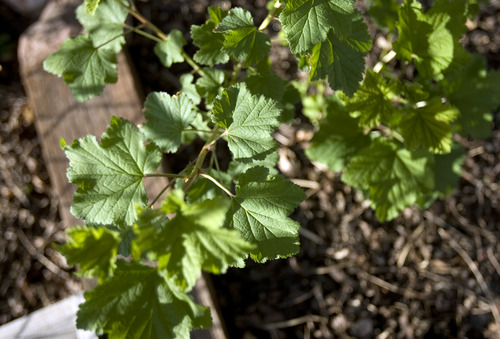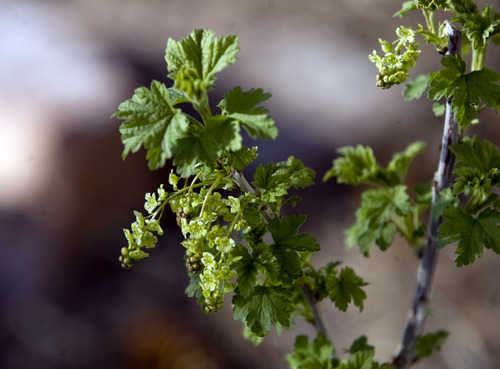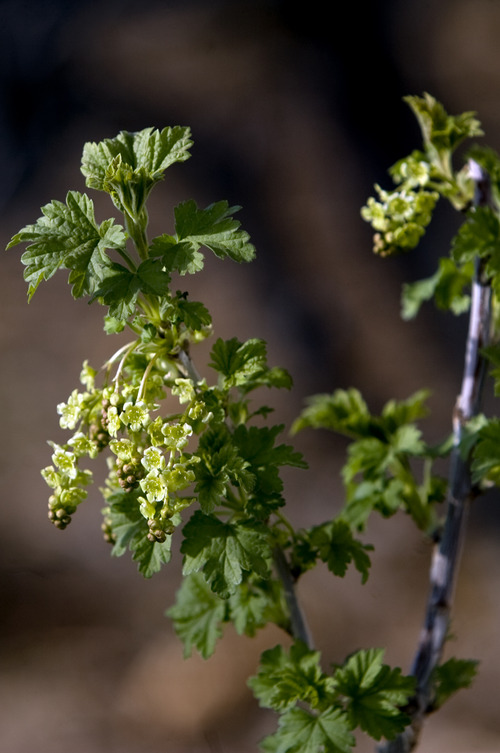This is an archived article that was published on sltrib.com in 2013, and information in the article may be outdated. It is provided only for personal research purposes and may not be reprinted.
If you have always wanted fruit trees in your yard, but the landscape just couldn't accommodate them — either because of limited sun, mature landscaping, or a small plot — fruiting shrubs might be the answer.
Currants, gooseberries and jostaberries are members of the Ribes family and are some of the smallest fruiting shrubs, growing only 2 to 6 feet tall and wide, but producing prolifically. They are a smart choice if you have a small space but still want to grow fruit at home.
If you want a larger shrub think about western sandcherry, Nanking cherry or serviceberry.
Small options • Growing on low, thornless, shrubby stems, currants tend to be small and mildly tart, although their flavor varies widely depending on the color — either pink, white, red, yellow or black.
Gooseberries have a sour reputation, however, some cultivars boast sweet, large berries that grow on thorn-free plants. Depending on the specific cultivar's characteristics, the size, relative sweetness, overall flavor and fruit color of both currants and gooseberries vary widely.
Jostaberries are a hybrid of the European black currant and a North American dessert-style gooseberry. The resulting berries are dark purple, large, sweet and mild, but that lack the musky flavor and scent characteristic of black currants. Jostaberries are vigorous, thornless plants that have a tendency to spread. They also boast a general resistance to disease, a quality that many varieties of the more delicate Ribes lack.
All of these berries will set fruit more reliably if they are planted in pairs. Currants are particularly needy in terms of cross-pollination, requiring at least two different varieties of the same species. Once your plants have set fruit, you can expect to harvest the berries over 2–4 weeks in late June or July.
If the area where you live reaches temperatures in the high 90s or above during the summer, you may want to consider planting your currants, gooseberries and jostaberries in partial shade. Ribes plants are known for their cold-hardiness but suffer in extreme heat; most grow best planted in cool, rich soil in zones 3–6. They also prefer to grow in soil that is slightly acidic (in the range of 6.5 pH), so if a soil test indicates high alkalinity, you may want to add peat moss or other acidifiers to your soil in the spring.
Western sandcherry • A member of the rose family, the western sandcherry is commonly found in Utah gardens. It is a practical and striking addition to the home landscape for many reasons: moderate water requirements, ability to thrive in sandy soils, low spreading growth habit and small, numerous flowers that blossom each spring.
Unlike its relative, the purple-leaf sandcherry (Prunus x cistena), western sandcherry (Prunus besseyi) also produces juicy, tart black cherries in the late summer or fall.
Like other sour cherries, the fruit of the western sandcherry makes excellent juice, jams, jellies and syrup; it can be used in place of tart cherries in recipes. The fruit can also be eaten fresh or dried (with or without the pits left intact). Because it's self-pollinating, only one must be planted to produce fruit; and sandcherry shrubs are entirely thornless, making them friendly, as well as space-conscious, additions to the edible landscape.
In the fall, western sandcherry's deciduous gray-green foliage turns brilliant shades of orange and red, offering one final show before the plant shuts down for the season. Sandcherry shrubs spread by sending up new shoots from the plant's base and generally grows to be 4 feet tall by 6 feet wide when mature. Western sandcherry prefers full sun and well-drained soil and is hardy in zones 3–8.
Nanking Cherry • Native to central Asia, Nanking Cherry is an extremely hardy shrub once established, tolerating bitter cold in the winter and scathing heat in the summer. It grows 6- to 8-feet high and equally as wide. Unlike many other tough plants, Nanking cherry also is beautiful, boasting keen visual interest in three of the four seasons (its fall color is unremarkable). In spring, this multi-branched shrub bursts into blossom when most other plants still appear to be completely devoid of life. Despite its tendency to bloom early, its resilient flowers can endure a fair amount of frost. Once flowers set fruit (helped along by a second plant to act as a pollinator), this fast-growing, vigorous shrub will supply scads of sweet-tart cherries between the middle and the end of summer.
Nanking cherries are excellent fresh but can also be processed into juice or jelly. Despite their flavor and productivity, Nanking cherries are rarely grown commercially because their fruit is soft and its shelf life, short—all-the-more reason to grow this ornamental edible at home. Nanking cherries are also one of few modern fruiting plants that come true from seed, making it easy to share starts with friends. This undemanding shrub prefers to be planted in full to part sun and well-drained soil and will grow happily in zones 3–6.
Serviceberries (AKA "Juneberries") • Blueberries are acid-loving plants, so Utah's highly alkaline soil can't realistically provide them with the environment they need to thrive. However, the Utah serviceberry, a blueberry look-a-like, actually prefers alkaline soil. In the early spring, serviceberry shrubs bloom prolifically; their white blossoms give way to pink berries that deepen to dark blue or purple when they ripen in the mid to late summer. Depending on the variety, this multi-branched, large shrub also offers breathtaking autumn foliage in shades of purple, orange and yellow.
Serviceberries taste like juicy sweet cherries with a hint of almond, and although they can be eaten raw by the handful, they can also be dried, frozen, juiced, used in baked goods and processed into jams and jellies. Serviceberries are highly self-fertile, so only one is needed to yield fruit, though they will produce more reliably when planted in pairs. The Saskatoon serviceberry, generally thought to grow the berries with the best flavor, is available in many local nurseries. Some varieties of serviceberries can grow quite large (up to 20 feet high and just as wide); however, the size and spread of the shrub can easily be contained from year to year by pruning out suckers and excessive top growth. Serviceberries will grow in part shade but prefer full sun and freely draining soil. They are hardy in zones 4–8.
The Ribes Family
Because currants, gooseberries and jostaberries are unconventional fruit crops, few pesticides have been developed to combat their enemies. As a result, choosing varieties that have high natural resistance to pests and disease is important to growing them successfully. Here are some varieties that are both hardy and delicious, making them good choices for the home landscape.
Currants
Ben Sarek Black Currant • This black currant ripens early in summer, is a high yielder and produces large berries with a rich, full flavor. It is moderately resistant to white pine blister rust and powdery mildew.
Crandall Black Currant • This variety performs well in areas that have hot summers. The large fruits ripen in late summer and have a mild flavor. The canes of this currant are weak, so a heavy crop may require trellising. Crandall has excellent resistance to both white pine blister rust and powdery mildew.
Titania Black Currant • Titania's large berries ripen concurrently in mid to late summer, making this a good choice for gardeners who want to harvest fruit over a short period of time (for processing juice or jelly). The fruits have a mild flavor but can become bitter if left to ripen for too long. Titania black currants are immune to white pine blister rust and show good resistance to powdery mildew.
Perfection Red Currant • Very cold hardy but sunscalds easily, making it better suited for planting in areas where summer sun is less severe. The large fruits develop in long, easy-to-pick clusters and ripen in mid to late summer. It shows good resistance to white pine blister rust but only fair resistance to powdery mildew.
Stephen's No. 9 Red Currant • One of the most popular red currants in North America, this cultivar grows large berries on vigorous canes. The fruits ripen in midsummer. Stephen's No. 9 shows good resistance to both white pine blister rust and powdery mildew.
Tatran Red Currant • This high-yielding, vigorous, cold-hardy cultivar bears large currants in long clusters that ripen in midsummer. Tatran is resistant to white pine blister rust, but its level of resistance to powdery mildew is unknown.
Gloire des Sablons White Currant • The currants borne on this European cultivar ripen in early summer and are pinkish-white with a sweet, mild flavor. The berries are of medium size, and the plant shows good resistance to both white pine blister rust and powdery mildew.
Gooseberries
Captivator Gooseberry • Captivator bears medium-sized, greenish-red to red berries with good flavor in midsummer. This moderately vigorous cultivar is less spiny than some other varieties and has good resistance to both white pine blister rust and powdery mildew.
Jahn's Prairie Gooseberry • This dessert-type gooseberry bears high yields of large, red-pink berries that grow on thorny canes. The plant is resistant to white pine blister rust, leaf spot, stem Botrytis, aphids and sawflies.
Pixwell Gooseberry • The small- to medium-sized, pale-green to pinkish-red berries ripen in midsummer, and the berries hang below the canes, making them easy to pick by hand. These berries are best suited to processing. Vigorous and reliable, this cultivar has high resistance to both white pine blister rust and powdery mildew.
Poorman Gooseberry • The small red berries are sweet and aromatic; they begin to ripen in midsummer. This vigorous cultivar has fewer spines than many other varieties and also shows good resistance to both white pine blister rust and powdery mildew.
Stanbridge Gooseberry • One of only a few varieties of gooseberry that develops few or no spines, Stanbridge bears a moderate yield of small, yellow-green fruits, and its canes are upright and vigorous. Stanbridge's resistance to white pine blister rust is unknown, but it shows good resistance to powdery mildew.
Jostaberries • Josta, Jostagrande/Jogrande and Jostaki are the three most commonly grown Jostaberry varieties. Josta" will bear fruit on its own, though it will produce more reliably with a mate. Jogrande and Jostaki will need companion plants to set fruit. The marble-sized berries of all three of these are dark purple and sweet, suited to both fresh eating and preserving or processing for later use.


